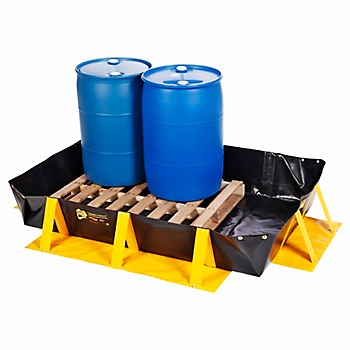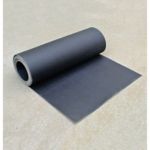
PIG® Collapse-A-Tainer® Spill Containment Berm
PAK791
Write a Review
122cm x 183cm x 30cm, 678 L Sump Capacity
As Low As £605.15 (Ex. VAT)
Create affordable drive-in containment anywhere you need it in just a few minutes.
Read More
PRICING (Based on quantity)
| 1 - 2 | 3 + |
|---|---|
|
1
- 2 £637.00 (Ex. VAT) |
3
+
£605.15 (Ex. VAT) Best Buy |
| Best Buy |

Description & Specifications
Create affordable drive-in containment anywhere you need it in just a few minutes.
- Re-engineered to provide exceptional value whilst maintaining the quality and performance you expect from PIG Collapse-A-Tainers
- No assembly required; collapsible sidewalls have attached skirt with outside aluminium-reinforced supports that help the walls stay rigid and upright
- Sides fold down easily to allow pallet jacks and forklifts to be driven in and out of containment
- Constructed of a durable, coated geomembrane that resists chemicals, abrasion and tearing
- Folds to a compact size for easy transportation and storage
- Convenient one-piece design requires no additional parts or tools
- Ideal for use under storage tanks, tote tanks, pillow tanks, pallets loaded with drums and more; store in trucks for emergency response to tank leaks in remote locations
- Overall floor space required - 183cm W x 244cm L
- Custom sizes available; call for details
| Maximum Working Temperature | 65°C (150°F) |
| Colour | Black and Yellow |
| Dimensions | 122cm W x 183cm L x 30cm H |
| Sump Capacity | 678 L |
| Folded Dimensions | 61cm W x 74cm L x 18cm H Folded |
| Usable Floor Space | 122cm W x 183cm L Floor Space |
| Wall Type | 4 Manual Walls |
| Sold as | 1 each |
| Weight | 12.7 kg |
| # per Pallet | 10 |
| Composition |
Co-polymer geomembrane - 28 mil. nominal; PVC wall supports and skirt; Aluminum support struts |
| Sump Dimensions | 122cm W x 183cm L x 30cm H |
Optional Accessories for PAK791
Reviews
Based on 0 review(s)
Additional Information
- Chemical Compatibility for PIG® Collapse-A-Tainer® Spill Containment Berm
- Instructions for PIG Collapse-A-Tainer Spill Containment Berm
-
The Control of Pollution (Oil Storage) Regulations (Northern Ireland) 2010
The Regulations apply to above ground oil storage facilities on industrial, commercial and institutional residential sites. They also extend to companies who refine or distribute oil. The Regulations set minimum design standards for new and existing above ground oil storage facilities, codifying existing good practice to ensure that above ground oil storage facilities are adequately constructed. A key requirement of the Regulations is for the storage container to have a secondary containment system (a bund, which is an outer wall or enclosure designed to contain the contents of an inner tank, or, a drip tray) to ensure that any leaking or spilt oil is contained and does not enter the aquatic environment. -
The Control of Pollution (Oil Storage)(England) Regulations 2001
This regulation applies to any container with a storage capacity of over 200 litres, and applies to any industrial, commercial or institutional site, e.g. factories, shops, offices, hotels, schools, public sector buildings and hospitals. All types of oil except waste oil are included. A bund or catchpit has to form a container around the tank capable of holding 110% of the contents of the oil stored or 25% of the total volume, whichever is greater. This is known as secondary containment. -
The Water Environment (Oil Storage) (Scotland) Regulations 2006
This regulation applies to any container with a storage capacity of over 200 litres. It affects all premises, including land and mobile plant, as well as private dwellings. "Oil" means any kind of oil and includes petrol, diesel, waste and vegetable and plant oil, but does not include bitumen. The storage container, whether indoors or outdoors, must be situated within a secondary containment system capable of holding 110% of the contents of the oil store or 25% of the total volume (whichever is greater). -
The Water Resources (Control of Pollution) (Oil Storage) (Wales) Regulations 2016
The Regulations apply to any kind of oil, including petrol, diesel, kerosene, lubricating oil (both mineral and synthetic), waste oil, vegetable and plant oil, and apply to any kind of container which has a capacity of greater than 200 litres which is being used to store oil above ground, whether inside or outside a building. This includes fixed tanks, intermediate bulk containers (IBCs), drums (oil drums or similar containers used for storing oil) or mobile bowsers. The Regulations will come into force in 3 stages - Tanks installed after 15 March 2016 will have to comply with the Regulations from the date they are installed; Existing tanks at significant risk (i.e. facilities that are located within 10 metres of any surface water or wetland, or 50 metres of a borehole or well), will have to comply within 2 years (i.e. by 15 March 2018); Existing tanks not at significant risk will have to comply within 4 years (i.e. by 15 March 2020). The secondary containment system must contain at least 110% of the maximum contents of the oil container, or at least 25% of the total storage capacity if multiple containers are stored, whichever is the greater.















